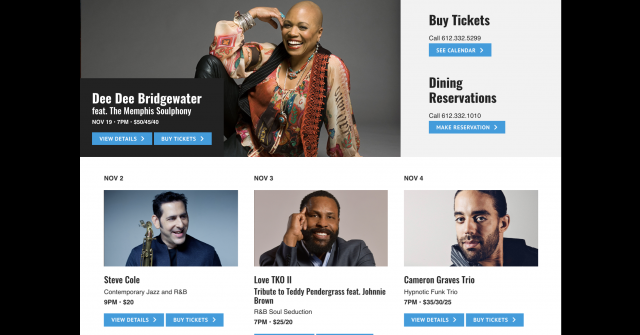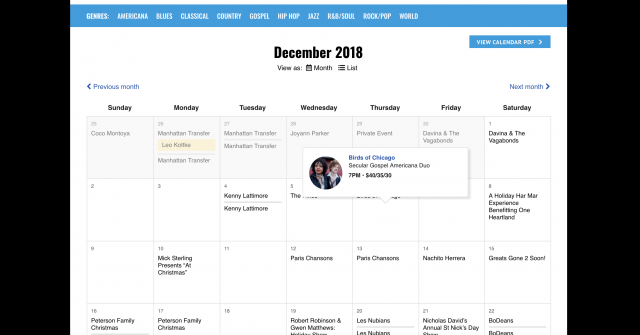In its three decades of operation, the Dakota Jazz Club and Restaurant has made a name for itself as a go-to spot for jazz fans in the Twin Cities. Now, the venue wants audiences to know that the Dakota isn’t just for listening to jazz, but discovering all genres of music. Today the Dakota launched a new website as part of its initiative to pivot away from its full name, “Dakota Jazz Club and Restaurant,” to simply “Dakota.”
The venue first opened its doors in St. Paul’s Bandana Square in 1985, and most of its early programming included local jazz artists. Through its early years, the Dakota forged connections with jazz legends like McCoy Tyner, and began drawing larger acts. The venue relocated to its present location on Minneapolis’ Nicollet Mall in 2003, and in recent years has been moving away from booking mostly jazz to hosting a multitude of musical genres.
To reflect the diversity of its programming, the Dakota is launching a new marketing campaign which includes a redesigned website, new graphics for its flyers, posters, and pre-concert slideshows. The venue will still officially be named the Dakota Jazz Club and Restaurant, but wants its patrons to know the club as just “the Dakota.”
“We’re still doing business as the Dakota Jazz Club and Restaurant, but as far as we’re marketed and how people have come to know us, people just say ‘the Dakota,’” said the venue’s general manager, Martina Priadka. “That really sums up our full genres of music better than ‘Dakota Jazz,’ which used to be how people shortened it. With the way that [founder] Lowell [Pickett] is booking the room, clearly it’s much more than jazz.”
The biggest change that the Dakota is rolling out is its new website. The site, designed by Minneapolis digital agency Brave New Media, features a minimal blue, white, and black color scheme and a crisp homepage filled with large photos that replaces the venue’s old text-heavy and cluttered design. The website includes a number of new features like a Spotify playlist of upcoming acts.
Another feature of the new website is the option of sorting upcoming concerts by genre. Priadka hopes that organizing shows by genre will help expose audiences to new artists with whom they may not already be familiar.
“We’ve talked about it for years, being able to let people shop by genre, given the fact that we’re a multiple-genre [venue], but a lot of our artists are not well-known by our local audience — although they might have national recognition or world recognition, it may take a deeper look into who they are to really understand their music,” she said. Some of the genres listed on the Dakota’s website include Americana, blues, country, gospel, hip-hop, and rock/pop.
Is there a way to categorize the type of music that the Dakota is booking now? “Good music,” said founder Lowell Pickett. “Over the last half-dozen years or so we’ve expanded tremendously; now it’s just great music, and it’s every conceivable kind of music,” he said, pointing out the range of artists that have visited the Dakota, from composer and pianist Philip Glass to veteran singer-songwriter Graham Nash (of Crosby, Stills & Nash), and Kamasi Washington’s keyboardist, Cameron Graves.
Pickett says the Dakota’s musical diversity is possible because of recent changes in how music is distributed from the artists to their fans — with the internet making the process more transparent, audiences have a multitude of styles available at their fingertips, and artists can enjoy greater freedom in expression without the pressure of fitting into narrow constraints of musical genre.
“I believe really strongly that if someone loves good music of one style, they will likely love good music of another style,” said Pickett. “Years ago, radio markets used to define styles, and record companies played to that because they wanted their songs on the radio. That still exists in radio to a degree, but the Internet has changed all of that. Just browsing through the Internet, people are going to be exposed to different genres of music, and chances are they’ll discover something that didn’t know existed, and they’ll find they enjoy it.”
In addition to booking a wide range of musical styles, the Dakota aims to book a mix of well-known and emerging artists. “We’ll do really exciting emerging artists, we’ll do legendary artists who normally would never be expected to be seen in a room as small as ours, as intimate as ours — Prince played there for a few nights a few years ago,” said Pickett, referencing when Prince booked the Dakota for six consecutive nights in 2013. Prince would visit the Dakota regularly to watch a range of performances, and had his own private table at the venue.
While the Dakota has hosted musical legends like Prince, McCoy Tyner, and Esperanza Spalding, the venue also wants to stay true to its roots by booking local artists. Pickett says that he wants the Dakota to be “a showcase for a lot of the great talent that exists in the Twin Cities.”
What type of music can we expect from the Dakota? Pickett hopes to keep filling the club with a broad musical spectrum. “As long as that’s the case — that people like coming in and hearing that variety, we’ll keep presenting that variety.”
Colleen Cowie runs the blog Pass The Mic.


